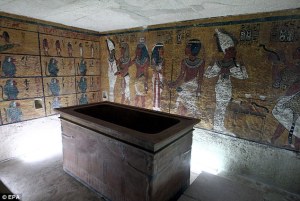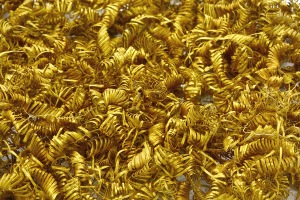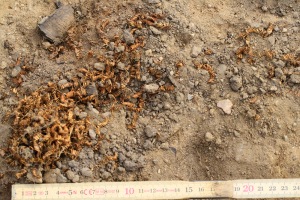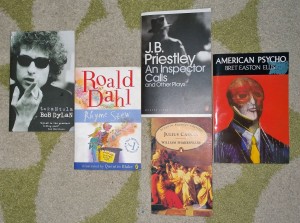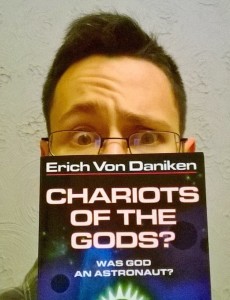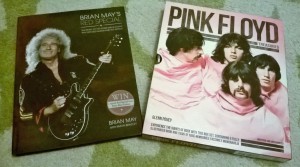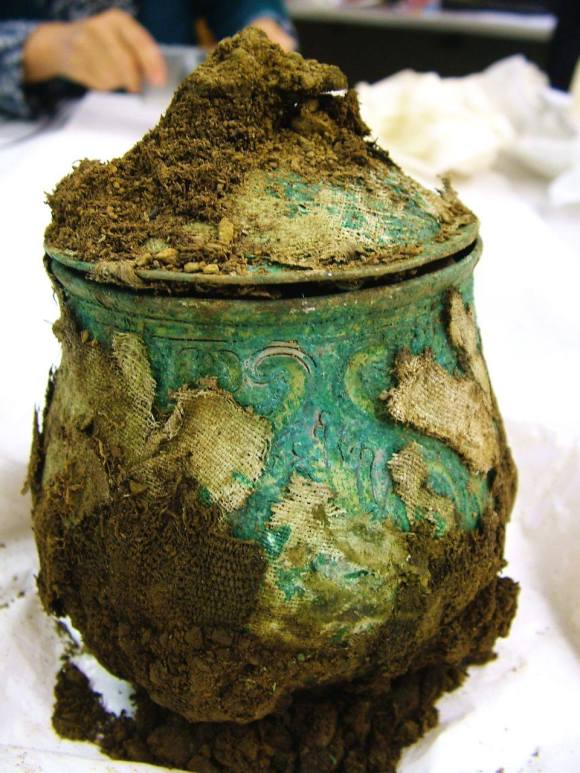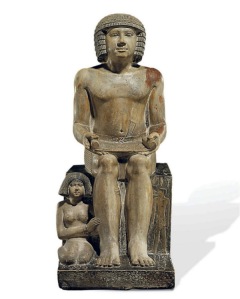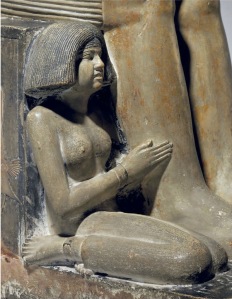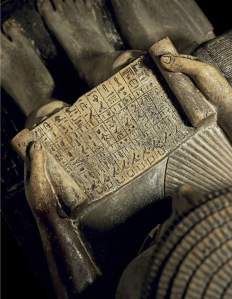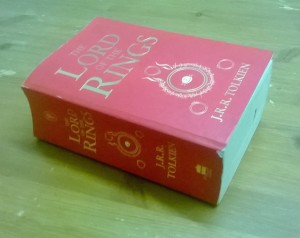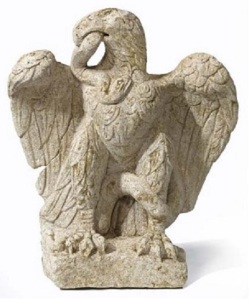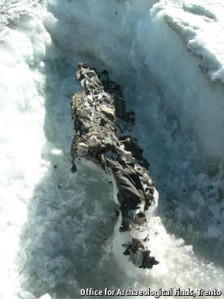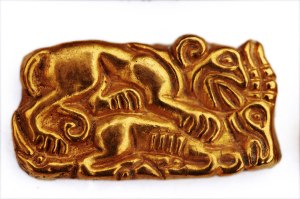An interesting story appeared in the news the other day. Nicholas Reeves from the University of Arizona has been studying detailed scans of the inside of Tutankamun’s tomb, made by Factum Arte, which were produced in order to make a facsimile of the tomb. He believes that he has found on the images evidence that points to a hidden, sealed doorway within the tomb that may lead to an undiscovered chamber or series of chambers. All very exciting stuff. However, he also thinks that these chambers could house the remains of Nefertiti, the consort of Akenaten, and the woman who some believe may have been the mother of King Tut. I was slightly surprised when I first read this, as I thought she’d already been found in KV35 in the Valley of the Kings with a cache of other royal mummies, but after doing a bit of digging (no pun intended), it seems as though she was just one possible contender for these remains, and DNA testing carried out a few years back has disproved this and the maternity issue. However, I can’t help but feel that this suggestion is a bit premature, and is purely designed to provoke speculation, interest, media coverage, and increase the chance of permission being granted for work to take place in the tomb. Where is the evidence for this? It would be amazing if it was the case, but an undiscovered chamber of Tut-related tomb goods would be just as interesting and archaeologically valuable. I don’t think I’ll hold my breath on this one, but would love to be proved wrong.
Electric Puppet
Also at: facebook.com/electricpuppetblog
Category Archives: Archaeology
Strange gold spirals from Denmark
This is a short mention of an interesting archaeology story that came out at the start of the month. An excavation in Boeslunde, south-west Zealand, Denmark, has revealed an unusual find of around 2,000 fine gold spirals, dating to around 900-700 B.C. Previous excavations here have brought up 10 gold rings- six of which were large and heavy, and four of which may have been ‘oath rings’ (typically found in sacrificial settings). With this new find, the site has now provided the most gold artefacts by weight from the Northern European Bronze Age. The spirals are made from extremely pure gold that was hammered flat to just 0.1 millimetre thick, and all together weigh between 200 to 300 grams (7-10 ounces). It has been suggested that the spirals may have once been woven into hair or used on some ceremonial clothing or headdress of some kind. A large lump of the coils may have sat originally in a birch wood box with a leather lining, based on remnants found at the scene, with others found in bunches of three or four, but archaeologists don’t seem to know what they were used for (they were probably ritual then…). To my mind they seem to look more like shavings or waste product from some sort of manufactory process, but what seems like careful disposal would make this unlikely. I don’t know- I’m probably wrong. If anyone reading this post does know any more about this find or have any theories, please feel free to post these below- I’d be glad to hear them!
New books: May
Yep. I’m behind again. I’ve still got book reviews to type, and a few archaeology and anthropology posts to do. Will I ever get round to them? Perhaps not. For now, May’s books:
- Bob Dylan – Tarantula 50p
- Roald Dahl – Rhyme Stew 50p
- J.B.Priestley – An Inspector Calls and Other Plays £2.99
- William Shakespeare – Julius Caesar 20p
- Bret Easton Ellis – American Psycho 50p
I also picked up this:
Don’t shoot me- I know it is shite, and just a cursory glance across the text and its grainy b&w plates reinforces the level of pseudo-archaeological, cod-scientific bull crap that it contains, but it is the book that got my Tutor at Oxford into archaeology, and I thought it worth buying just for that, and the comedy value. It was also only 50p. Expect a scathing deconstruction of this at some point, as I do intend on reading it soon.
New books: December and CHRISTMAS!
There’s quite a few to be getting on with here! First of all, those bought over the course of December:
- Kurt Vonnegut – Slaughterhouse 5 25p
- Louis de Bernieres – Red Dog 25p
- Penelope Lively – Treasures of Time 25p
- Brendan O’Carroll – The Chisellers 25p
- Andrew Shail & Robin Stoate – BFI Film Classics: Back to the Future 50p
- Niccolo Machiavelli – The Prince 50p
- Frank Parkin – Past Masters: Durkheim 50p
- Tom Baker – The Boy Who Kicked Pigs 50p
The first four books were from a library sale, and I do already have a copy of the Vonnegut book, which I had for free from my Sixth Form when they were clearing out their library. However, this copy here is a lot better, so for the price I thought it worth ‘upgrading’. Also, I never realised that Tom Baker (i.e. The Fourth Doctor) had written a children’s book. Oh, here I could go off on a ‘children’s literature as adult literature’ rant, but I won’t.
Now for Christmas! I hope you all had a goodtime, and here are some of my new books:
- Carol Ann Duffy – The Christmas Truce – Dorothy Wordsworth’s Christmas Birthday
- In Flanders Fields: Poems of the First World War
- Russell Brand – The Pied Piper of Hamelin
The WWI book is a rather nice copy, in a slip case, and the Russell Brand book is a (whisper it!) children’s book, but also illustrated by Chris Riddell, one of my favourite illustrators.
- The Jedi Path
- Book of Sith
- The Bounty Hunter Code
Yep, I like Star Wars. In fact, I really like Star Wars. And these are rather indulgent books, made to look like they’re written by various characters, and annotated by others.
- Brian May with Simon Bradley – Brian May’s Red Special: The Story of the Home-Made Guitar that Rocked Queen and the World
- Glenn Povey – Pink Floyd Treasures
I also really like Queen. And Pink Floyd.
- Mock the Week’s Only Book You’ll Ever Need
- Chris Fern & George Speake- Beasts, Birds and Gods: Interpreting the Staffordshire Hoard
- Paul Parsons & Gail Dixon – The Periodic Table: A Field Guide to the Elements
That last book is going o come in quite useful for reference at work, and the Hoard book is of particular interest, as it looks into the animal imagery of the Hoard and places it in a wider Anglo Saxon context. Also, George Speake works at the Institute of Archaeology in Oxford, so I may have come across him once or twice in my time there.
Anglo-Saxon goldsmiths’ tricks: The Staffordshire Hoard
As I’ve said several times before, I’m from Stoke-on-Trent, and one of the most interesting things to happen to our City (and indeed our county) for quite a long time was the discovery in 2009 of the Staffordshire Hoard. I was one of the many people who queued to see it when it first went on display five years ago, and it was this that inspired both my dissertation and my enduring love of the Anglo-Saxons, which I hope to potentially pursue academically in future years. I came across a story in the news last week regarding this, and thought it worthy of sharing.
It turns out that some of the pieces within the collection are not quite as pure as you would expect, and that Anglo-Saxon goldsmiths occasionally tricked their royal clients using rather clever methods. Two years of research funded largely by English Heritage has shown that the makers of some of the material in the Hoard used a weak solution of ferric chloride (thought to have been made by heating up a mixture of water, salt and iron-rich clay [or maybe dust from crushed up old Roman tiles]) to remove silver and other impurities from the top few microns of gold at the surface in order to enhance the visual purity of the material. The Anglo-Saxons are known to have used this method for creating contrasts between shades of gold, this is the first time such a method has been observed as being used to enhance the purity of the metal. This would have altered greenish pale-yellow, gold/silver alloy of around 12-18 karat into deep gold, 21-23 karat material.
By comparing the Hoard material with that from Sutton Hoo, it is now thought that items made for royalty were being produced of pure gold, whereas that for the lower nobility was made from this chemically-altered alloy. There is also the possibility that this sort of surface purification may also have taken place in order to make the best of the quality of the gold used to make the item- perhaps the objects which have been treated in this way were of a slightly later date than those with the purer body, and were made from substandard gold. It is known that the quality of gold coming into England from the Continent declined over the 6th and 7th centuries, and so we could be seeing evidence of this here.
As with all of the work surrounding the Hoard, it seems that for every discovery made, there are twice as many questions raised!
—————————————
To keep abreast of the latest news about the Hoard and for some rather interesting scientific articles regarding analysis of various pieces, check out the Staffordshire Hoard website: http://www.staffordshirehoard.org.uk/
A Viking Hoard from Scotland
I don’t know if you saw this in the news a few days ago, but a metal detectorist has discovered a hoard containing over 100 gold and silver Viking items in Dumfries and Galloway, which is thought to be the largest Viking hoard discovered in recent times, and contains many unique items. One of the most impressive items is a silver enamelled cross on a chain from the 9th-10th century, with depictions of what could be the four Evangelists (this will become clearer after the artefact has been cleaned), but there were also dozens of silver ingots and arm rings, as well as an interesting bird-shaped pin, gold rings and other items. Below the initial assemblage was then found a further collection of objects, and it was here that there was found a complete Carolingian silver vessel with the lid still in place, from about 100 years before the rest of the hoard. This item poses interesting questions about the trade links and connections that the Vikings in this region had, and allows us to speculate what may have been kept inside or may still be inside, before it is opened and analysed. It is though that this may be the largest Carolingian silver vessel ever discovered. As with many other hoards, It is unknown why this collection of rich material was buried and why it was never reclaimed, but I look forward to hearing more about this as the conservation gets underway.
I do like the movies – honest!
Following on from the last cartoon that I posted here, I thought I’d add this before getting onto serious archaeology:
Let’s hope it squishes him
This made me laugh, so I thought that I’d share it. Interestingly, I shared that clip from Indiana Jones in the first Archaeology lesson I taught this week just gone, as a prime example of how said explorer is not an archaeologist. I mean, come on. We all know that archaeology is not like that, and that real archaeologists would have been more interested in the rolling ball scene in the inscriptions on the walls, in the way that the traps worked, in the poison used on the darts, in the construction techniques of the temple itself, and indeed everything else, with the gold statuette coming rather low down the list of informative and interesting things to look for and study. Also, there is no recording carried out of the findspot for the statuette either. All very infuriating.
Sekhemka update
Well it definitely looks like Northampton Museum won’t be getting an Alan Moore manuscript. Following my last post about Northampton Council’s plans to sell an ancient Egyptian statue, I’m a tad irritated to say that the sale went ahead on the 10th July, with Sekhemka selling for the ridiculous sum of £15,762,500- about two-and-a-half-times the expected sale price. The good news for the council is that they won’t need to raise as much money as they had planned to in order to go ahead with their new construction work- they need £14m, and have got about £10m towards that once the 45% of the sale price owed to the Marquis of Northampton has been paid. This interesting arrangement highlights the somewhat dodge nature of the sale, as the question arises whether it was actually the property of the council to sell in the first place, and makes the legal position one to watch.
However, probably the most interesting thing about the sale was the fact that it drew attention from Egyptian government officials, who seemed quite concerned that their heritage was being sold off in another country, and that the object shouldn’t be sold anyway, as it had been stolen from Egypt. Yep; this would be the same Egyptian government who are quite happy to allow the heritage in their own country to crumble, be looted and blown up without a care, as it doesn’t reflect the true people of the country (i.e. those who live there now). I would laugh if it weren’t so tragic.
Alan Moore and Sekhemka
I never thought that the topics of graphic novels and ancient Egyptian archaeology would ever come up in the same post, but it seems that they will now. One example (out of many, many examples) of a council being idiotic has been playing away in the news for a few weeks, but now I thought that it would make an interesting post, what with the introduction of Alan Moore- of ‘Watchmen’ and ‘V for Vendetta’ fame- to the fray.
Northampton Borough Council has decided that the best way for it to raise the eight-figure sum that it needs to cover the cost of “a new entrance to the Guildhall Road site, new galleries, a Shoe Resource Centre, education spaces and retail, food and drink facilities as part of the town’s Cultural Quarter” (according to culture24.org.uk) is to sell an Egyptian statue in its collection. This 4,500-year-old statue of Sekhemka was collected by Spencer Joshua Alwyne Compton, 2nd Marquess of Northampton (1790-1851), in Egypt between December 1849 and April 1850, and donated to the people of the city by the 4th Marquis of Northampton in 1880. His descendant Lord Northampton has reached an agreement to share the proceeds of the sale with the council, and it is expected to make £6m at Christie’s on 10th July.
Here is a description taken from the sale catalogue:
Lot 10. AN EXCEPTIONAL EGYPTIAN PAINTED LIMESTONE STATUE FOR THE INSPECTOR OF THE SCRIBES SEKHEMKA
OLD KINGDOM, DYNASTY 5, CIRCA 2400-2300 B.C.
Depicted seated, wearing a tight-fitting wig with rows of carefully-cut curls, his expressive face intact and beautifully carved with subtly moulded brows, his eyes looking slightly downward, with a short nose and a softly modelled mouth, the slightly smiling lips outlined by a raised vermillion line, wearing a short pleated kilt with a knotted belt and a pleated tab angled above, holding a partially unrolled papyrus scroll on his lap with a hieroglyphic inscription listing twenty-two varied offerings, his powerful bare chest with clearly indicated collar bones, muscular arms and strong legs, his hands finely detailed, a hieroglyphic inscription on the seat reading: “Inspector of the scribes of the house of the master of largess, one revered before the great god, Sekhemka”; to his right, his wife in much smaller scale kneeling, her left leg bent elegantly beneath her right, her left arm tenderly embracing Sekhemka’s right leg, wearing a tight-fitting ankle-length dress, the accompanying inscription reading: “The one concerned with the affairs of the king, one revered before the great god, Sitmeret”; to his left a young man sculpted in raised relief, most probably his son, with an inscription reading: “Scribe of the master of largess, Seshemnefer”; the three sides of the cubic seat sculpted in shallow raised relief with a ceremonial procession of male offering bearers bringing a duck, geese, a calf, lotus flowers, unguent and incense
29 ½ in. (75 cm.) high; 12 ¼ in. (31.2 cm.) wide; 17 3/8 in. (44.1 cm.) deep
Estimate: £4-6 million ($6,784,000-10,176,000)
Provenance
Probably from the Royal Cemeteries, Saqqara.
Acquired by Spencer Joshua Alwyne Compton, 2nd Marquess of Northampton (1790-1851), in Egypt between December 1849 and April 1850.
Presented to the Northampton Museums and Art Gallery by either Charles Douglas-Compton, 3rd Marquess of Northampton (1816-1877) or Admiral William Compton, 4th Marquess of Northampton (1818-1897).
Exhibited
The Northampton Museum, Northampton, general exhibition, 1866–1899.
The Abington Museum, Northampton, Egyptian room, 1899–1950s.
General exhibition, Northampton Central Museum, Northampton, from 1960.
The Abington Museum, Northampton, Ancient Egypt – Land of Mystery, 1977.
Northampton Central Museum and Art Gallery, Northampton, Mummies and Megaliths – the Bronze Age in Britain and Egypt, 1983.
Northampton Central Museum and Art Gallery, Northampton, Ancient Egypt: The Northampton Collection, 1988.
General exhibition, Northampton Museum and Art Gallery, Northampton, 2001-2012.
However, the Museums Association has warned that Northamptons future loans and fundraising prospects would be in jeopardy if the sale goes ahead, as members of the Arts Council are allowed to exchange items with other accredited venues and apply for grants and funding, but14m from once they have their share of the sale proceeds, if their most likely source of funding will be cut following the sale. Ironically, Councillor Brandon Eldred, of Northampton Borough Council, said before a ‘public consultation’ in 2012 that the money from the sale would be used to to a wider audience.
“The statue of Sekhemka is a valuable asset and we do appreciate its significance as an artefact,” he insisted. Hmmm.
“But we have decided to sell it and reinvest the money back into developing Northampton Museum and other parts of our cultural heritage. Every penny raised will go into projects that help to tell the story of our town’s history.”
Hmmm. I can’t help but feel that Northampton are shooting themselves in the foot somewhat with this. What could surely be made into a major attraction for people to the museum is being taken away in favour of what sounds to be a mediocre and somewhat substance-less redevelopment that would take away much of the heritage of the place.
Now, I hear you shout- where does the bearded cartoon god come in? Well, read this:
I think that he makes a valid argument, to be honest. Why would you willingly donate to an institution that is happy to sell its collections and donations to raise funds rather than raising them in the usual ways? Collect donations, charge entry, receive grants. I hope that the museum doesn’t manage to raise the rest of the money needed, and that the statue is purchased by another museum or institution to show Northampton up.
——————————————————-
It seems that the Christie’s catalogue actually provides quite a bit of information regarding the statue. This text is taken from nordonart.wordpress.com, which quotes from the sale catalogue extensively.
SCULPTURE IN THE OLD KINGDOM 2500 B.C. – ETERNITY
Life after death was the primary belief in ancient Egypt and preparing for one’s welfare after death was the project of a lifetime. A tomb needed to be built, funerary equipment had to be arranged, and the mortuary cult needed to be performed. Aside from the royal family, only the elite had the resources to fully realise these demands. The tomb was made in two parts, comprising a substructure where the sarcophagus was placed, and a superstructure with decorated rooms and chapels. It was a favour of the king to be permitted to have a sumptuously decorated tomb, given only to esteemed members of the administration. Artisans from the royal workshop would create the colourfully decorated walls and lifelike statues representing the deceased and his family.
Group sculptures representing the royal family are known since the early Dynastic period, circa 3000-2650 B.C. A relief fragment from Heliopolis shows an early depiction of king Djoser with his family gathered around his legs. The intimate attitude of the wife kneeling on the ground, her legs tucked to one side, her arm around her husband’s legs was reserved only for royal women in the 4th dynasty (circa 2600-2450 B.C.). Only in the 5th dynasty did non-ruling members of the royal family adopt this style, as with the example of the statue of princess Nebibnebty and her husband Seankhuptah, dating to circa 2450-2300 B.C. This type was subsequently gradually adopted by high officials and entered private statuary shortly after.
Only one other statue is attributed to Sekhemka, Inspector of the Scribes, and is in the Brooklyn Museum. The kneeling figure is made of diorite, the base is in limestone, painted to imitate diorite and is decorated as an offering table. It is suggested that Sekhemka may have had a discarded royal sculpture repaired and a base added to it. The similar quality of the carving between this and the present lot certainly serves to link the two pieces. Moreover, both statues were brought out of Egypt at around the same time; Dr. Henry Abbott, the original owner of the Brooklyn Sekhemka, returned with his collection in 1851.
SESHEMNEFER
On the front of the cubic seat, to the right of Sekhemka, is a figure of a young man, Seshemnefer, walking to the left. He is depicted nude, a sign of youth, and holds a large lotus flower with long stem in his left hand, the symbol of rebirth. As well as providing his name, the hieroglyphic inscription above his head identifies him as a scribe of the master of largess, which suggests that he worked in the same office as his father. That such a young man already has a work title may appear incongruous, however this is a depiction of Sekhemka’s son as an idealized youth. His presence reinforces the carefully constructed image of an idyllic, young and fecund family.
SITMERIT AND INTIMACY IN ANCIENT EGYPT
Sekhemka’s wife, Sitmerit, meaning literally “The Daughter of Merit”, is shown kneeling to his right. Though diminutive in scale, her refined features are stately and beautiful. Her imposing wide wig frames her round face, whilst rows of straight and curling natural hair appear on her forehead. Her eyes gaze upwards, in the same direction as Sekhemka’s. She is wearing a tight-fitted white linen dress, revealing the shape of her body. The dress was patterned in blue and orange around her breasts, as the remains of pigment behind her shoulders reveal. Her wrists and ankles are adorned with bracelets and traces of a broad collar are visible on her neck. She is delicately embracing her husband’s right leg, with her left hand carved on the inside of his calf.
Canons in Egyptian art were established by the royal family and followed by the elite, who were always trying to emulate their sovereign. Although appearing quite static at first glance, representations of royal and private couples always have an element of intimacy, showing conjugal affection. In the 4th dynasty, the wife is only touching her husband with one hand, but by the 5th dynasty, she will be gently brushing his calf with her fingertips. Later examples show husband and wife holding hands, arm in arm, or even embracing by the shoulders.
Here, the position of Sitmerit’s body, as well as her composed expression is perhaps what gives peacefulness and harmony to this family portrait. It shows the close link between husband and wife, and their attachment to their family. The smaller scale is not a symbol of women’s place in society; rather, it is an artistic choice, for women had an equal status with men. She provides the love and support that her family needs. She prompts desire, gives life, and watches over her loved ones. She has a protective role and is the grounding force for the family.
THE SCROLL
Sekhemka holds a papyrus scroll open on his lap. The hieroglyphic inscription lists offerings, with much detail about type and quantity, including food, beverages, unguents and liquids, incense and cosmetics, funerary equipment and royal gifts. These are the essential offerings that Sekhemka will need to subsist comfortably in in the afterlife.
Register I
Water-pouring
Incense
Festival perfume, one jar
Hekenu-oil, one jar
Sefet-oil, one jar
Nehenem-oil, one jar
Tuaut-oil, one jar
First quality cedar oil, one jar
First quality Libyan oil, one jar
Green eye-paint, one bag
Black eye-paint, one bagRegister II
Cloth strips, a pair
Incense
Cool water; two pellets (of natron)
An offering-table
Royal offering, two cakes (?)
Royal offering of the hall, two cakes (?)
Sitting
Breakfast, bread and beer
One Tetu-loaf
One Te-reteh-loaf
One Nemeset-jar of beer
Vindolanda gold
A nice story to emerge in the past few days- after nearly 50 years of excavation, the first Roman gold coin has been discovered at the fort of Vindolanda, Hadrian’s Wall. This may sound like nothing more than a magpie response, but in fact the presence of such an object can provide us with questions regarding the people who were living and working at the camp. The gold aureus was in circulation for around three centuries, and dates from A.D. 64-65 , depicting the emperor Nero. The coin would have been worth 6 months pay to a soldier stationed at the fort, and it is the value of the piece that makes the find so unusual. The owner of such a high-denomination coin would be unexpected to lose something so valuable, hence there being no other such examples found at Vindolanda, and it is unlikely that any more will be found.
The coin will go on display at Vindolanda after being intensely studied and analysed, and a last point to make is that it was not discovered by a professional archaeologist, but rather a regular volunteer at site. Now, Vindolanda is an interesting site, as the excavations that take place here are heavily paid-volunteer-based. If you are interested in joining a dig here, or simply want to learn more about the site, click on this link:
Skulls for sale
I mentioned in my last post that I had recently come across a story regarding the sale of human remains. Well, at the start of this month, an auction was prevented from taking place in the US town of Hagerstown, Maryland, of the skull of a soldier killed in battle during the Civil War. This skull was uncovered on a farm in Gettysburg in 1949 and was thought to be the first sale of its kind, but was stopped after the hotel carrying out the auction received numerous complaints. Now, the skull has been ‘donated’ to the United States Parks Services in Gettysburg, Pennsylvania, who can provide a proper burial.
Now, I don’t really think that I need to explain why I take issue with the thought of selling human remains- the fact that this was a part of a deceased individual’s body make the whole concept of possession and ownership faintly ludicrous. I can’t just go and sell a person, or remove their limb and then sell it, so why should this be okay and permissible once they are dead? The same issue arises for me with human remains in anthropological and museum collections, and even more so with the sickeningly immoral practice of one Gunter Von Hagen, who sells jewellery and framed images containing thin slices of preserved corpses. No thank you. You do not buy or sell the dead. People are people, and people were people, not commodities. I could get into a whole new Anthropology debate here over consumerism and consumption, but I won’t.
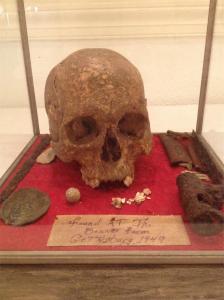
Image: http://www.your4state.com
Dulux paints from history: Mummy Brown

‘Examination of a Mummy – A priestess of Amman’ by Paul Dominique Philippoteaux c 1891. Image: Peter Nahum at The Leicester Gallery, London
I don’t often do this, as I’m sure that nobody ever bothers to click on the links I provide, but in case anyone is interested, here is a ridiculously fascinating article about the trade in and use of Egyptian mummies for medicinal purposes and paint pigment up until the early 20th century. I learnt a great deal from this, and was somewhat repulsed and upset by it. Just think of all that history that we have lost due to the plundering of Egypt by Western nations for various reasons, and that blatant economic exploitation of the remains of the dead (which incidentally reminds me of another post I must write shortly, which I meant to get up last week but which totally slipped my mind), with no regard for their status as once-living individuals, and for what they could have told us about the past. How many famous pharaohs were there for the discovery, only to be ground up as cod-scientific medicines thanks to a misunderstanding of Egyptian embalming techniques? As an Archaeologist, it’s truly heartbreaking to think about, but all we can do is make the most of the knowledge and resources that we have now, conserve what we have of the past still to hand, and take these tales from history as both lessons in bad practice, and as interesting chapters in the history of the discipline. Spilt milk, and all that. Anyway- here’s the article. Do take a few minutes out to read it- it is well worth it.
http://www.artinsociety.com/the-life-and-death-of-mummy-brown.html
Ancient socks for sandals
I’ve just found this image on Facebook, and thought it worthy of a post on here. These are clearly a pair of interestingly-shaped socks. However, perhaps more interesting is the fact that they are Romano-Egyptian socks from 250-420 AD, excavated from Oxyrhynchus, Egypt, at the end of the 19th century. The strange toes come from the fact that these were made to be worn in sandals. I’m just staggered by the wonderful preservation of these items considering their age.
————————-
After a quick Google search, this came up regarding these socks from the V&A (their current home):
The Romano-Egyptian socks were excavated in the burial grounds of ancient Oxyrhynchus, a Greek colony on the Nile in central Egypt at the end of the 19th century. They were given to the Museum in 1900 by Robert Taylor Esq., ‘Kytes,’ Watford. He was executor of the estate of the late Major Myers and these items were selected among others from a list of textiles as ‘a large number of very useful examples.’
And Emily Spivack, writing in the Smithsonian, adds:
Particularly intriguing about these “very useful examples” is the technique used to construct these red wool socks. Called nålbindning, or single-needle knitting, this time-consuming process required only a single thread. The technique was frequently used for close-fitting garments for the head, feet and hands because of its elastic qualities. Primarily from prehistoric times, nålbindning came before the two-needle knitting that’s standard today; each needle was crafted from wood or bone that was “flat, blunt and between 6-10 cm long, relatively large-eyed at one end or the eye is near the middle.”
We don’t know for sure whether these socks were for everyday use, worn with a pair of sandals to do the ancient Egyptian equivalent of running errands or heading to work—or if they were used as ceremonial offerings to the dead (they were found by burial grounds, after all).
This reminds me of a story I was told by a professional archaeologist friend about an exhumation he was carrying out at a local church. An elderly lady who had died in the 1960s was being carefully removed, and she was entirely skeletal. However, over her feet were a pair of intact, perfectly-preserved and almost knee-high socks.
New Books: April
As promised on my last book-purchases post, here are my new acquisitions from April (albeit a tad late):
- Geoffrey Berg- The Six Ways of Atheism: New Logical Disproofs of the Existence of God 10p
- Patrick Moore- The Guinness Book of Astronomy 10p
- Lesley and Roy Adkins- The Keys to Egypt: The Race to Read the Hieroglyphics 20p
- Suetonius- The Twelve Caesars 99p
- Caesar- The Conquest of Gaul 99p
- The Paston Letters 10p
- Charles Dickens- Great Expectations 20p
- E. W. Hornung- Raffles 20p
- Penelope Lively- Moon Tiger 20p
- Yevgeny Zamyatin- We £2
- Ralph Ellison- Invisible Man £2
- Leo Tolstoy- War and Peace 50p
- Mary Shelley- Frankenstein 10p
- Philip K. Dick- The Man in the High Castle 50p
- Jonathan Swift- Poems Selected by Derek Mahon Bought for me
- William Shakespeare- Henry IV Part 2, The Taming of the Shrew, Twelfth Night 50p each
Also, I had these bought for me (which I’d asked for):
- Timothy Taylor- The Prehistory of Sex: Four Million Years of Human Sexual Culture
- Evelyn Waugh- Brideshead Revisited
- Hermann Hesse- Strange News from Another Star and Other Stories
- Dante- The Divine Comedy Volume I: Inferno, The Divine Comedy II: Purgatory, The Divine Comedy III: Paradise (I translated by Mark Musa; II translated by Dorothy L. Sayers; III translated by Dorothy L. Sayers and Barbara Reynolds)
A British Chalcolithic?
A recent excavation of the Neolithic portal dolmen of Perthi Duon on the island of Anglesey has revealed the following artifact:
Now, this may not look like much, but this small piece of metal may prove to be very important in terms of the chronology of prehistoric Britain. It is thought that this small artifact is a piece of copper, and if this is the case, then it may provide evidence for a British ‘Copper Age’. The Copper Age (or Chalcolithic) was a period at the beginning of the Bronze Age, before the discovery of the technique to produce bronze by mixing tin and copper, and has been evidenced in the archaeological record on the European continent. However, it is unknown whether such a period can be defined for Britain, or whether the process of bronze production was brought to this island without copper being used first. It is hoped that this small piece could provide evidence for such a period here, however it is going to need testing and analysing first before such a claim can be satisfactorily made. It may turn out to have entered Britain as a completed object, meaning that the technology may not have been brought, and bronze could have been made here first, or it could have been formed here, suggesting the technology for copper working was in place in Britain. I am personally quite excited by the prospect of a British Chalcolithic, but am hesitant to jump to too many conclusions on the basis of this one object. I shall look out for updates with interest though.
The truth of archaeology- BEWARE!

Image: Archaeology Trowels and Tools (https://www.facebook.com/archstore)
Yup- archaeology isn’t all Indiana Jones. It’s a hell of a lot better.
A new low for TV and a slap in the face to proper archaeology
I’ve only heard about this programme recently, and so am aware that much has already been said about it, but National Geographic are planning on 13th May to air in the UK a ‘documentary’ entitled ‘Nazi War Diggers’. The clips of this show already released were quickly taken off the internet after the negative comments started, and to be honest, it is easy to see why. The programme sees a group of individuals (I can’t call them archaeologists, for the simple reason that they aren’t) digging up remains of fallen Second World War soldiers in Latvia, with the proposed intentions of ‘sav[ing] this history from being looted or lost’.
However, the only ‘looting’ that seems to be taking place is that by the presenters of this programme. I have seen several television documentaries where battlefield archaeologists excavate French trenches and battlefields from WWI in order to return the bodies of loved ones to their families for proper reinterment. These excavations are carried out with sensitivity, for a legitimate reason, and by professionally trained archaeologists and osteologists using correct archaeological excavation procedures. I do not have an issue with this, and if this is what ‘Nazi War Diggers’ was about, then there would be no issue. The footage, however, that was released and the images abounding on the ‘net that have been taken from the programme or used to publicise it show a group of inept amateurs digging away with no regard for archaeological techniques or contexts (for example, using sharp tools close to bones, not recording the material found in any way, and pulling bones out of the ground using brute force, rather than carefully and slowly excavating around them), and much less regard for the individuals whose remains they are removing.
Dr Tony Pollard, the Director of the Centre for Battlefield Archaeology at Glasgow University, has said this about the programme:
I’m appalled that a major broadcaster has sunk to the levels of exploitation television. I’ve been at the forefront of battlefield archaeology for fifteen years, and I have spent much time getting the subject taken seriously.
This just looks like they’ve gone around digging up bodies, because TV likes a dead body.
This shows no evidence of even the most basic archaeological principles – this is treasure hunting not archaeology.
I have seen human remains brandished like trophies before but in dodgy YouTube videos. The fact that this comes from a commissioned TV series is quite beyond belief.
The trailer on the internet was absolutely shocking, and very damaging for National Geographic.
Whether these bodies are those of Allied soldiers, German soldiers, or soldiers of any other nation, they should not be handled and removed in such a way that shows such basic disregard for common decency, human morality, the ethics of the past, or for people who were someone’s son, friend, father or brother. A pile of human bones is not just a collection of objects (it is indeed that, but not just that)- it is the physical presence of a person who is no longer alive and who is no longer in the world to defend and protect themself. There is no reason why these remains should be treated with any less respect than those buried in cemeteries or those held in museums, and the trivialisation of their removal and handling is lamentable. Not only do the diggers (I can’t call them excavators, because this suggests some sort of archaeological methodology has been adhered to) pull bones out of the ground, but they blatantly show scant knowledge of osteology or human anatomy, and worryingly little evidence of what they do with the bodies once they have removed them.
Not only is this programme a new low for television and its need to broadcast crap catering to the lowest common denominator, but it is also a shot in the foot for the once-respectable National Geographic, and a body-blow to the good name of archaeology, and battlefield archaeology in particular (which has a bad enough time of it as it is, with many people against such excavation, and which often finds itself having to defend itself way too much). I shall not be watching this programme for fear of throwing something through my screen whilst it is on, and have decided against posting any images to illustrate this rant, as I do not want to condone what those idiots have done in any way. As an archaeologist, I see the historic, scientific, practical and moral need to excavate human remains, and in recent years massive steps have been made in this field when it comes to repatriation of bones and body parts to those of other cultures, and in the general handling and study of such material. This, though, does not mean that I condone the gratuitous unearthing of individuals when there is no motive other than selfish self-publicity and the need to increase television viewing figures. Will the production team carry out tests on the bodies in order to return them to the families for reburial? Will they rebury them in a manner befitting a dead soldier? I think not, and it is truly shameful.
One last thought: I wonder if such a programme would be permissable were it Allied soldiers being excavated in France or Belgium in such a way? Is it because these individuals were ‘Nazis’ that such ill treatment is possible? Are we still to retain such pointless and ridiculous prejudices?
An intact Bronze Age burial on Dartmoor
Okay, this post is a little late considering this story was in the media almost two weeks ago, but just incase you may have missed it, I thought I’d put it up anyway. Better late than never and all that.
In 2011, a Bronze Age cist was discovered on Dartmoor on Whitehorse Hill, near Chagford, containing an intact cremation burial.
Remarkable in itself for being undisturbed, this burial has been described as one of the most important archaeological discoveries of the last 100 years, as well as the most important ancient find on the moor, and the contents are soon to go on display to the public.
The cremation was wrapped in an animal pelt that had survived incredibly due to being buried in peat, and this fur also contained a fragment of textile (possibly a belt or sash) with a leather fringe, a bracelet (which I will discuss below), and a coil-made basket. Within this basket were discovered about 200 beads, with some made from shale, and others of amber traded from the Baltic, a flint flake and wooden disks believed to have been used as either stud earrings or inserted into a belt, made from spindle wood. This is a hard, fine-grained tree that grows on Dartmoor, which traditionally is used to make knitting needles, and these pieces are the earliest examples of wood-turning in Britain, being unique in the archaeological record of the island. Prior to this find, only eight beads had been found on Dartmoor from the Bronze Age within the last 100 years, and so this discovery has greatly increased the volume of material from this period that is available for study.

The basket removed from the burial, which contained the beads, wooden earrings and flint flake. Image: BBC
However, despite the presence of amber suggesting a high status individual due to the magical associations with this material and its part in long-distance Continental trade, it is the bracelet that is of real interest due to the decoration included. The bracelet itself is made from woven cow hair, with 35 studs originally included (three are now missing) as decoration made from worked tin. This is particularly interesting, as it provides the earliest example of worked tin from the South West of Britain, and tin in itself is rare in the prehistoric record as decoration. As well as the bracelet, this excavation also revealed a bead made from tin.
It is believed that this burial belonged to a female aged between 14 and 25 who was of a high social standing, and the location of the cist on a site 600 metres above sea level that would have been visible to much of the surrounding landscape suggests a person who needed to be seen and remembered by many people over a wide region.
Another library booksale
Again, our two children came out best from this latest sale at one of our local libraries, getting well into double-figures for only a few pounds. However, I did manage to get a few (the last two are not from the library though):
- Vladimir Nabokov – King, Queen, Knave 25p
- Christopher Hope – The Love Songs of Nathan J. Swirsky 25p
- John Preston – The Dig 25p
- Ian McEwan – On Chesil Beach 25p
- John Steinbeck – Of Mice and Men £1
- Philip K. Dick – Do Androids Dream of Electric Sheep? £1.50
I’ve already read ‘Of Mice and Men’, as I studied it at GCSE, but have never had my own copy until now, and the Preston book ‘The Dig’ is a fictional account of the discovery of Sutton Hoo in 1939. I have to commend the cover of the Nabokov book, too, as it is in the same vein as the ‘Just So Stories’ cover that I was so taken by in my ‘Thoughts on…’ post a few months back. Here it is in more detail:
I just love the simplicity of the image, on what is already a simple design (the 2000’s Penguin Modern Classics silver-stripe covers). It doesn’t have the playfulness of the ‘Just So Stories’ cover, with the swinging leopard’s tail, but I still think that this is a perfect example of less-is-more.
I’m also slightly annoyed with myself for buying the McEwan book, as I’ve said for a while that I’d never buy any of his simply because they seem to me to be too populist, but I didn’t think that I could argue with 25p. To be fair, the Classics that I am so enamoured of are only such due to being ‘popular’, but I tend to think of McEwan’s books to not be overly literary, due in part to them having won all of the awards that are over-hyped and over-biased. Anyway- only reading it will tell me whether it was a good move or not, and I will probably end up loving it and needing to buy all of his other books too. Probably.
Christmas Books
It’s taken me a few days to get around to writing this post, but here I finally am. These first few are ones that I picked and therefore knew my partner was saving for me for Christmas:
- Jostein Gaarder – The Ringmaster’s Daughter
- Jerome K. Jerome – Three Men in a Boat
- J.G.Ballard – Crash
I also knew about this next one. You may remember a month or so ago that I was unable to pick up my old edition of ‘The Hobbit’ and ‘The Lord of the Rings’, and that I had decided to purchase one of the pleasantly-designed boxsets (see the discussion with myself in this previous post). Well, a while back I had a rather lucky find at the local library booksale:
This was also saved until Christmas, and was a ridiculously good find- £20 worth of book for 10p! ‘The Hobbit’ isn’t included, but I should be able to pick that up at some point.
I also had:
- E.M. Forster – Maurice
- F.Scott Fitzgerald – The Last Tycoon
- Truman Capote – Breakfast at Tiffany’s
- William S. Burroughs – Junky
- Rudyard Kipling – Puck of Pook’s Hill (off my parents)
- Private Eye: A Cartoon History
- Nicholas J. Higham & Martin J. Ryan – The Anglo-Saxon World (off my parents)
- The Private Eye Annual 2013
- Private Eye: Eyeballs
Quite a nice amount of reading to be getting on with!
Banksy’s ‘Cave Painting’
Just a quick post- I came across this earlier, and wish I’d known about it sooner. I love it! I’m a fan of Banksy anyway, but adore this image due to it not only including a mocked-up archaeological image, but also because it comments powerfully on the treatment of and attitude towards graffiti art in the 21st century. Historical and archaeological graffiti, whether it is cave “art”, or the scrawled latin phrases seen at Pompeii and other Roman sites is seen as a record of past views, thoughts, styles and cultures, whereas recent graffiti is something to be despised and abhorred if it not in the correct place or of a temporary nature. Why can’t modern graffiti to the character and history of a place or a building in the same way? It is the archaeology of the present, and we will mourn it when it is gone. Anyway- something to think about!
The joys of library booksales
Before I start, let me just say that the books you are about to see haven’t all been bought from library booksales, despite what the title of this post says. However, we have managed to strike ridiculously with the sale in our local library, as our two boys now have about 15 or more new books for little over £3. Who would argue with that?
I didn’t get as many, but have acquired a few recently from other sources too. Before I list these, let me just mention these two books first:
Please forgive the absolutely atrocious quality of the photo, but they are:
- Plato- Republic 50p
- Francis Pryor- Britain AD: A Quest for Arthur, England and the Anglo-Saxons 50p
I meant to do a blog post on these over a week ago, but just never got around to it. The latter book has refueled my interest in the Anglo-Saxons (I haven’t really picked up on this recently, in part because all of my Saxon archaeology books are still sitting in large fruit-boxes in our boxroom, along with the majority of our other books), and it actually seems to be an academic text masquerading as a populist history work. Always nice. However, the main thing I want to say about these is just that I was quite shocked with the way the woman behind the counter in the charity shop looked at me when I handed them over to pay. Do people in our area not read such books? Are ancient Greek philosophy and Anglo-Saxon archaeology beyond the scope of people here, are were they just beyond her? I don’t know. Anyhoo. The other recent purchases stand as follows:
- Anthony Kamm- The Romans: An Introduction 50p (library book sale)
- Roald Dahl- Ah, Sweet Mystery of Life 10p (library book sale)
- Albert Camus- The Plague 25p
- Jean Rhys- Voyage in the Dark 50p
- Anon.- Sweeney Todd or A String of Pearls 50p
- Jules Verne- Journey to the Centre of the Earth 50p (Folio Society edition!)
- Stephen Hawking- A Brief History of Time: The Updated and Expanded Tenth Anniversary Edition 50p (library book sale)
- Lewis Carroll- Alice’s Adventures in Wonderland and Through the Looking Glass 10p (library book sale)
As you may recall from a previous post, I already own a copy of the Hawking work, but thought that 50p wasn’t bad for an updated edition; similarly, you may recall from a previous book-buying post and my ‘Thoughts on…’, I already have individual copies of the Carroll books, but for 10p… Well, there’s an intro. in this one, a series of notes, extra text not in the ones I had, and also the spine isn’t faded (as my individual copies were). Oh, and it’s published by Oxford University Press, too. Not bad. Also, the Roman book is published by Routledge, which is a very good publisher of archaeology texts, and appeared regularly in the bibliographies that accompanied my essays at uni. This book would actually have been handy to have had then, as it covers a lot of background about the Romans that would have been useful for essay background and revision.
I plan to get up soon several ‘Thoughts on…’ posts, as I’ve been reading quite a bit recently (as I said in my last post), and hope to get these done soon. The books I will be looking at are ‘Heart of Darkness’, ‘Roverandom’, ‘The Torrents of Spring’, ‘Just So Stories’, and ‘Diamonds are Forever’- so quite a bit to come!
The Strange Case of the Spontaneously Combusting Mummy
I haven’t posted on here for a few days, and am planning to get up a grand total of 4 ‘Thoughts on…’ posts (I’ve been reading quite a bit recently), but this caught my attention.
I have harboured an interest in the ancient Egyptians since I was 10, and before having children, I had intended this to be my chosen area of study, and later employment. Life intervened, however, and since then I have now realised that my real love in archaeology is the landscape and the Early Medieval period in England and Europe. Despite this change in focus, I have still held an interest and fascination in Egypt, and it was with great joy that I travelled several years ago with a very good friend of mine to the O2 in London to see the exhibition of treasures from the tomb of Tutankhamun.
I cannot adequately describe my amazement at the grave-goods on display- “Wonderful things” indeed- in part due to the sheer quality and the beauty of the craftsmanship, and also because of the fame of some of the items that I was able to see in the flesh, as it were. However, since then I think any further discovery surrounding the boy pharaoh has paled in comparison, and I have paid these new finds about the cause of death or his life less and less attention. Until now, that is.
Egyptologist Dr Chris Naunton has re-examined some of the notes made by Howard Carter back in 1922 and analysed a fragment of flesh that was removed from the mummy to reveal that a chemical reaction caused by the embalming oils used led the body to burn within the inner-most coffin once it had been sealed. I don’t know the ins and outs of this research, as I can’t find a lot of information regarding it, but there is a programme on Channel 4 later in the week, and so I hope to be able to say slightly more on this once I’ve watched it.
Personally, I think that this sounds an interesting idea, and when you look at some parts of the body, it does perhaps look as though it may have been burnt, but… I don’t know. I’m not entirely convinced, to be honest. Surely there would have been some sort of heat damage to the inner-most coffin and the bandages, and Carter does record some sort of burn damage, but- I need to find out more to make any proper comment. Expect a follow-up post to this one!
The best Roman sculpture ever found in Britain: An eagle in London
If any of you have ever seen Channel 4’s ‘Time Team’, you will be familiar with the idea that on archaeological excavation, many of the best and most exceptional finds are discovered right at the end of the last day of digging. Sadly, this is often not the case in non-televised archaeology, but in this one instance, it was the case. Archaeologists had been digging just outside the City of London on what is going to become a 16-storey, 291-bedroom hotel for several months when they uncovered the magnificent statue shown above in literally the last few hours of the last day of excavating. It was originally thought to have been a Victorian garden ornament due to its condition, but was soon recognised as being within Roman contexts; lying in a site known to have been a Roman cemetery. It has since been dated to the 1st or 2nd century AD, and is carved from Oolitic Cotswold limestone, standing 65cm tall and 55cm wide. A well-known school of sculptors worked in that area, and it is thought that this statue may prove the biggest and best example of their work so far unearthed. Indeed, the sculpture has been described as one of the best statues discovered from Roman Britain. It was found lying next to the foundations of a mausoleum, and is believed to have once adorned this, standing within an alcove that protected it from erosion by the elements. Such a location also explains the statue having a plain back.
The statue depicts an eagle devouring a serpent, and is seen to be a representation of good and life triumphing over evil and death. The image was therefore a popular one in funerary contexts, and eagles are also seen in Roman art as carrying the souls of the emperors to the gods- allowing the mortal to become divine. There is also the possibility that it could have adorned the tomb of a member of the ‘cult of Jupiter’ that was popular at the time the statue is thought to date from, and as such would have also provided a protective role for the deceased.
Prior to this discovery in September, a fragment of what is thought to have been a similar statue was found at Keynsham Villa, Somerset:

The statue fragment from Keynsham Villa, Somerset, with possible reconstruction. Image: Anthony Beeson.
The only other (near) complete example of such an eagle eating a snake was found at Khirbet et Tannur, Jordan in 1937, and is now held in the Cincinnati Art Museum:
The statue is on display at the Museum of London for 6 months from yesterday, and will be well worth a look if you happen to be in the area. personally, I think that it is a truly superb find, and just hope that the rest of the site managed to reveal many further secrets even if they were not as visually striking as this piece. Also, it just shows that occasionally, real archaeology can be like ‘Time Team’!
Two soldiers in the Italian ice
Following on from my two previous posts about an Iron Age tunic and an Iron Age horse discovered in a Norwegian glacier, I came across this story through a friend. In the Presena Glacier, part of the Italian Alps, there was uncovered last year the preserved bodies of two soldiers who were killed in the Battle of Presena in May 1918. It is thought from both their location and their uniforms that these two individuals may have been Austro-Hungarian mountain troops called Kaiserschützen, who fought against Italian Alpini to defend the mountains during the First World War. As could be imagined, the cold (reaching as low as -30°C), storm and avalanches killed as many people as the fighting did, but one of the two soldiers was found to have a bullet hole in his skull and a piece of shrapnel lodged inside. Due to the power of the glacier, the bodies were also fused together, but forensic analysis suggested that these people were both 17 or 18 years old. It is also interesting to note that these individuals were discovered in the same mountain range as Ötzi, the 5,000 year-old “Ice Man”, and that he was ironically in better condition due to having only been frozen and not crushed like the soldiers. Despite being separated by millennia and by wildly different cultures, these soldiers were found to be wearing coverings over their boots that had been made for them by the Russian prisoners used to transport ammunition and resources up the mountains, and which were very similar to those worn by Ötzi.
Once analysis had been carried out on the remains, they were buried in unmarked graves, as DNA- although present- was unidentifiable due to having no other identification on the bodies by which to narrow down who these boys were or where they came from. Again, this is in contrast to the “Ice Man”, who recently had around 16 of his descendents traced in Austria. The place in which they were interred was in the village of Peio, which is now in the italian province of Trentino, but was in 1918 the highest village in the Austro-Hungarian Empire. The Emperor decided that as such, it should not be evacuated, as many other mountain villages close to the front line were, but after the war in 1919 it became Italian. This has led to Trentino and the neighbouring South Tyrol sharing a sense of belonging to both Austria and Italy, as well as meaning that in the “White War” that took place on the Presena Glacier and elsewhere in the mountains, the men fighting on opposing sides may have known one another before the war and been friends. Indeed, this previous familiarity and sense of similarity was seen when troops exchanged gifts on Christmas Day during the hostilities.
A slightly more disturbing discover this time from the ice, but again it shows that glaciers are a mine of information about the past- whether this is ancient or recent- and a precious resource that we need to protect in order that more information and more people are not lost and forgotten forever.
LiDAR and landscape archaeology in the New Forest
LiDAR- Light Detection and Ranging- systems work by firing a pulsed laser beam from an aircraft many thousands of times a second. These pulses then pass through any vegetation or undergrowth and bounce off the ground, to be picked up by on-board detectors, and then converted into 3D CGI images. Such systems are used in the archaeological study of landscapes to build up a better and clearer ideas of the way sites in the past interacted with on another and fit into the topography of the landscape, showing the lines of sight and viewsheds available, as well as a plethora of other uses. One of these other uses is to find hidden and buried features, and this has been employed to spectacular effect recently by archaeologists in the New Forest, Hampshire. The New Forest National Park Authority (NPA) has said that experts have surveyed a 350-square-mile region, with much being hidden under dense forest, but the really exciting thing about this is the fact that over 3,500 new sites and areas of interest have been discovered. Amongst the finds have been prehistoric field systems, Bronze Age burial mounds and an Iron Age hill fort, with the new surveys contributing to our knowledge of two Bronze Age barrows on Beaulieu Heath. All-in-all, this seems to have been a very profitable piece of landscape archaeology, and should produce fruitful study and research opportunities for many decades to come. I shall look out for further findings with interest!
More Iron Age treasures from Norway.
It seems at the moment as though glaciers are becoming as prevalent for archaeology as car parks. A few weeks ago, I posted a piece about an Iron Age tunic and arrows that have been found due to thawing ice, and now the Lendbreen glacier near Lillehammer, Norway, has thrown up another Iron Age item of interest: a horse. This perhaps doesn’t sound too exciting in itself, but it is actually rather interesting as it is one of the only examples of a horse discovered from this period that is at such a high altitude. It is thought that this glacier was used from the Late Iron Age to the Early Medieval period as a short cut across the mountains, but the view proposed by Lars Pilø, the Head of Snow Archaeology* at Oppland council, is that this animal would once have been used to transport reindeer carcasses down the mountains. In the summer months, horseflies affect the deer and force them to higher altitudes where the insects cannot survive, which also makes the ice the perfect hunting ground due to its lack of cover and good visibility (i.e. dark animal on white snow). Personally, I am unsure how we can really say which theory is correct, as any load would have been removed from the horse once it had died and therefore there would be little to inform us of its original purpose in that location. However, it does show us again that this glacier (and presumably many more glaciers besides this one) have a vast number of secrets still to tell us.
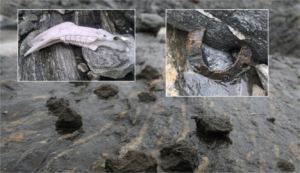
Main image: Preserved Iron Age horse manure. Inset (L): A piece of the horse’s skull. Inset (R): An Iron Age horse-shoe. Image: Oppland County Council
* I’m intrigued! Snow archaeology? Is the study of features highlighted by the snow a distinct area of archaeology or does it come under landscape and reconnaissance? Or is it something different? I think I may need to do a bit of research!
An extraordinary kurgan discovery
Now, until I studied A Level Archaeology, I had believed a kurgan to be a villain from the 1986 film ‘Highlander’:
However, I am now older and slightly wiser, and can see the fascinating insights that these kurgans in their archaeological sense can provide us with. I can across an article earlier today on a Sarmatian kurgan excavated in the Russian Southern Ural steppes by the Institute of Archaeology (Russian Academy of Sciences), and it is truelly amazing what has been discovered. Until this point, I did not really know anything about Russian (or indeed any European) nomads except that some actually practised tattooing several millenia ago, but this find from the 1st millennium BC is the Iron Age equivelant to our own dear Sutton Hoo. These Sarmatians and other nomads called Scythians interacted with both Persian and Classical Greek culture whilst managing to retain their own distinct style that can be illustrated in some of the amazing artifacts uncovered from this recently-excavated kurgan. The finds are believed to suggest that this burial contained a woman- assuming that you subscribe to the dated and gender stereotyped view of 1970’s archaeological theory that women can be identified in the burial record by jewellery and mirrors. Osteological indications suggest a man, however, and I would be more inclined to believe this, to be honest.

The burial chamber showing the body, and some of the grave goods. The mirror is visible to the middle right of the image, and the silver container on the top left. Image: Leonid Yablonsky.
Apparently, this particular mound had been excavated 20 years ago and had revealed 26 “golden” deer statuettes, but the section unearthed this year had been left unexplored. In a passage near the enterance the team found a cast bronze cauldron with a diameter of 102 cm, with handles decorated in a Scythian-Siberian animal style showing two griffins beak-to-beak:
Within the intact burial chamber, which measured 4x5m and was 4m deep, there was found a skeleton, and near to the skull, a wicker chest. This may have been a ‘vanity case’, and was filled with items including: a cast silver container with a lid; a gold pectoral; a wooden box; cages; glass; silver and earthenware bathroom flasks; leather pouches and horse teeth containing red pigments. There was also a large silver mirror, as well as items of clothing decorated with several plaques that showed flowers, rosettes and a panther leaping on a saiga’s (antelope) back. Breeches, a shirt and a scarf were found to have 395 pressed pieces of gold leaf sewn onto them, with the shirt having its sleeves embellished with multicoloured beads, and a fringed shawl was held together with a golden chain. Also, two cast gold earrings were decorated in places with cloisonné enamel and found on the skeleton, suggesting that they had been worn on the corpse. Less ornate were two stone mixing palettes that were discovered, along with gold-plated iron needles and bone spoons and pens decorated with animals- but it is believed that these were used to carry out tattooing. In all, there were over 1000 artifacts uncovered, and a few can be seen below:
This excavation has certainly opened my eyes to a society that I previously knew next to nothing about, and has certainly excited me to find out more about these Iron Age peoples. A couple of days of research are in order over the next few weeks, I think.!

